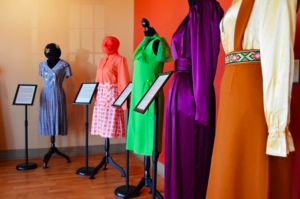COOKEVILLE — It’s a history lesson on fashion — Cookeville fashion, that is.
“What We Were Wearing: A Timeline of Cookeville Fashions” continues through April 16 at the Cookeville History Museum, spotlighting select pieces from Tennessee Tech University’s Historic Costume Collection as well as the museum’s own collection.
“Even though styles change, clothing the human form has always been an important part of our society and it is very cyclical — there are recognizable elements in today’s fashion that were popular 100-plus years ago,” Beth Thompson, Cookeville museums manager, said.
The timeline of fashion begins with 18th century long-hunter attire and continues through contemporary styles.
Hannah Upole, assistant professor of merchandising and design in TTU’s School of Human Ecology, initiated the collaborative exhibit with Thompson and museums exhibit specialist Pam Philpot. She has been in the process of cataloging and digitizing the Historic Costume Collection and wanted it to be something everyone in the community could experience.
“I worked with Pam and Beth to locate specific events or time periods that were relevant to the history of Cookeville and then pulled pieces from our Historic Costume Collection that correlated to those times,” she said. “My goal was to create an exhibit that allows visitors to look back on historic moments and create a narrative around the garments worn at that time — ‘What We Were Wearing’
“What We Were Wearing: A Timeline of Cookeville Fashions” continues through April 16 at the Cookeville History Museum. Admission is free.
New exhibit features timeline of Cookeville fashions to understand their importance, to visualize their meaning and maybe even remember when they wore similar items.”
Museum visitors will be able to see a variety of pieces, including handmade shirtdresses from the 1950s and authentic Jackie O-style shift dresses from the 1960s. Each garment includes a description of its important elements as well as how it would have been worn or styled.
“By taking a few minutes to read about each piece, visitors can have a quick snapshot into why these garments were selected and how they added to the history of Cookeville,” Upole said.
Philpot said she was thrilled to work with Upole to create the exhibit.
“There are lessons to be learned about how factors such as politics and the economy can influence fashion and vice versa,” she said. “Fashion is everywhere!”
Upole said she hopes the exhibit brings joy and that visitors can see themselves in some of the pieces and recall experiences with friends and family.
“I also hope it helps to teach visitors about the way clothing is connected to history — as clothing is not just a piece of fabric but a strong narrative about the time period it is connected to,” she said.
TTU’s full Historic Costume Collection features more than 1,500 donated pieces dating from the mid-1800s to modern times. It is a “working educational collection,” Upole said, that TTU students can borrow from for educational purposes, whether it be reviewing them to create their own garments, incorporating them into visual merchandising displays or presenting them in historic fashion shows. To learn more about the collection or if interested in donating a garment, call TTU’s School of Human Ecology at 931-372-3157.
“What We Were Wearing: A Timeline of Cookeville Fashions” may be viewed at the Cookeville History Museum, 40 E. Broad St., Tuesday through Saturday from 10 a.m.-4 p.m. Admission is free. For more information, call 931-520-5455.


